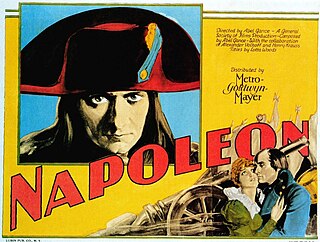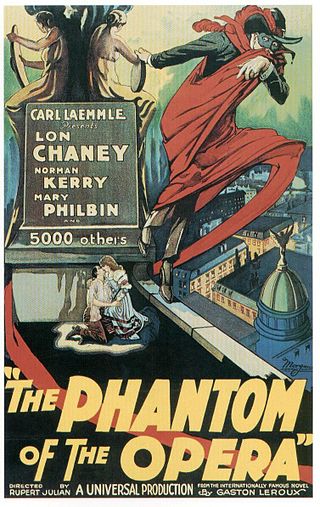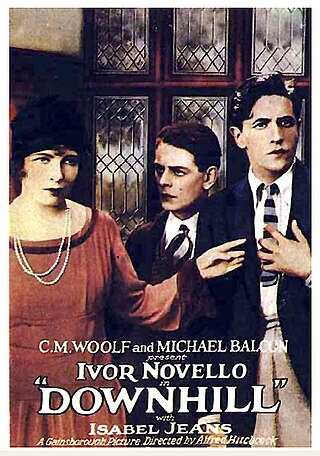
Safety Last! is a 1923 American silent romantic-comedy film starring Harold Lloyd. It includes one of the most famous images from the silent-film era: Lloyd clutching the hands of a large clock as he dangles from the outside of a skyscraper above moving traffic. The film was highly successful and critically hailed, and it cemented Lloyd's status as a major figure in early motion pictures. It is still popular at revivals, and it is viewed today as one of the great film comedies.

Napoléon is a 1927 French silent epic historical film, produced, and directed by Abel Gance that tells the story of Napoleon's early years. It is also the only film to use Polyvision. On screen, the title is Napoléon vu par Abel Gance, meaning "Napoleon as seen by Abel Gance". The film is recognised as a masterwork of fluid camera motion, produced in a time when most camera shots were static. Many innovative techniques were used to make the film, including fast cutting, extensive close-ups, a wide variety of hand-held camera shots, location shooting, point of view shots, multiple-camera setups, multiple exposure, superimposition, underwater camera, kaleidoscopic images, film tinting, split screen and mosaic shots, multi-screen projection, and other visual effects. A revival of Napoléon in the mid-1950s influenced the filmmakers of the French New Wave. The film used the Keller-Dorian cinematography for its color sequences.

The Phantom of the Opera is a 1925 American silent horror film adaptation of Gaston Leroux's 1910 novel Le Fantôme de l'Opéra, directed by Rupert Julian and starring Lon Chaney in the title role of the deformed Phantom who haunts the Paris Opera House, causing murder and mayhem in an attempt to make the woman he loves a star. The film remains most famous for Chaney's ghastly, self-devised make-up, which was kept a studio secret until the film's premiere. The picture also features Mary Philbin, Norman Kerry, Arthur Edmund Carewe, Gibson Gowland, John St. Polis and Snitz Edwards. The last surviving cast member was Carla Laemmle (1909-2014), niece of producer Carl Laemmle, who played a small role as a "prima ballerina" in the film when she was about 15 years old. The film was released on September 6, 1925, premiering at the Astor Theatre in New York. Vaudeville stars Broderick & Felsen created a live prologue for the film's Broadway presentation at the B.S. Moss Colony Theater beginning on November 28, 1925. The film's final budget was $632,357.

Children of Paradise is a two-part French romantic drama film by Marcel Carné, produced under war conditions in 1943, 1944, and early 1945 in both Vichy France and Occupied France. Set in the theatrical world of 1830s Paris, it tells the story of a courtesan and four men — a mime, an actor, a criminal and an aristocrat — who love her in entirely different ways.

Downhill is a 1927 British silent drama film directed by Alfred Hitchcock, starring Ivor Novello, Robin Irvine and Isabel Jeans, and based on the play Down Hill by Novello and Constance Collier. The film was produced by Gainsborough Pictures at their Islington studios. Downhill was Hitchcock's fourth film as director, but the fifth to be released. Its American alternative title was When Boys Leave Home.

"Once Upon a Time" is episode 78 of the American television anthology series The Twilight Zone. It originally aired on December 15, 1961. It features early film star Buster Keaton in one of his later roles, as an unlikely time traveler, and the opening and closing scenes pay tribute to the silent films for which he was famous.

The Young Girls of Rochefort is a 1967 French musical comedy film written and directed by Jacques Demy. The ensemble cast is headlined by real-life sisters Catherine Deneuve and Françoise Dorléac, and features George Chakiris, Michel Piccoli, Jacques Perrin, Grover Dale and Geneviève Thénier, along with Gene Kelly and Danielle Darrieux.
Phonofilm is an optical sound-on-film system developed by inventors Lee de Forest and Theodore Case in the early 1920s.

The Thénardiers, commonly known as Monsieur Thénardier and Madame Thénardier, are fictional characters, and the secondary antagonists in Victor Hugo's 1862 novel Les Misérables and in many adaptations of the novel into other media.

Thief of Hearts is a 1984 American erotic drama film produced by Don Simpson and Jerry Bruckheimer. It was written and directed by Douglas Day Stewart.

Paris is a 2008 French comedy-drama film written and directed by Cédric Klapisch. Starring an ensemble cast, the film depicts the stories of a diverse group of people living in Paris. It began shooting in November 2006 and was released in February 2008. Its UK release was in July 2008.

Jacques de Baroncelli was a French film director best known for his silent films from 1915 to the late 1930s. He came from a Florentine family who had settled in Provence in the 15th century, occupying a building in the centre of Avignon then called the Baroncelli Palace. His father's side of the family were of Tuscan origin and part of the Ghibelline tradition, and they were hereditary Marquises of Javon. Though somewhat aristocratic, the family spoke Provençal, which was rather controversial at a time when it was considered to be a language of the common people. His older brother was Folco de Baroncelli-Javon,

Faces of Children is a 1925 French-Swiss silent film directed by Jacques Feyder. It tells the story of a young boy whose mother has died and the resentments which develop when his father remarries. It was a notable example of film realism in the silent era, and its psychological drama was integrated with the natural landscapes of Switzerland where much of the film was made on location.

Moulin Rouge is a 1928 British sound drama film directed by Ewald André Dupont and starring Olga Chekhova, Eve Gray and Jean Bradin. While the film has no audible dialog, it was released with a synchronized musical score with sound effects using both the sound-on-disc and sound-on-film process. The film is set in and around the Moulin Rouge cabaret in Paris.

Liliom is a 1934 French fantasy film directed by Fritz Lang based on the 1909 Hungarian stage play of the same title by Ferenc Molnár. The film stars Charles Boyer as Liliom, a carousel barker who is fired from his job after defending the chambermaid Julie from the jealousy of Mme. Muscat, the carousel owner who is infatuated with Liliom. He moves in with Julie and they begin an affair. When Liliom discovers he's about to become a father, he finds he needs money and participates in a robbery which goes awry. Rather than allow himself to be arrested, Liliom kills himself and his soul is transported to a waiting room of Heaven. A heavenly commissioner determines that Liliom will not be admitted into Heaven, only Purgatory, until he returns to Earth to do one good deed.

Gigi is a 1949 French comedy film directed by Jacqueline Audry and starring Gaby Morlay, Jean Tissier and Yvonne de Bray. A young girl who is coming of age and being trained as a courtesan by her family, and realises she not only adores the debonair, close family friend Gaston, who has spoiled her with attention and care for most of her life, but that she is in love with him. Gaston realises the same thing, and despite efforts of Gigi's down-to-earth, doting grandmother and charming socialite aunt to bring the couple together by the then socially accepted practice, it is the undeniable and compelling love between Gigi and Gaston that triumphs. Directed by Jacqueline Audry, who accentuates the humor of this piece without losing the sensitivity of the young love that takes center stage. The film was based on the 1944 novella Gigi written by Colette.

22 Bullets is a 2010 French gangster-action film directed by Richard Berry. It tells a part of the life story of Jacky Imbert, and is based on the novel L'Immortel (2007) by Franz-Olivier Giesbert. Filming began on 23 February 2009 in Marseille, in Avignon in early April 2009, and continued for 8 weeks in Paris.
One Man Band, also known as London and Swinging London is an unfinished short film made by Orson Welles between 1968 and 1971. The film started life as a part of a 90-minute TV special for CBS, entitled Orson's Bag, consisting of Welles' 40-minute condensation of The Merchant of Venice, and assorted sketches around Europe. This was abandoned in 1969 when CBS withdrew its funding over Welles' long-running disputes with US authorities regarding his tax status, and Welles continued to fashion the footage in his own style.

Sappho is a 1921 German silent film directed by Dimitri Buchowetzki and starring Pola Negri as the title character. Alfred Abel, best known for his role as John Fredersen in Metropolis (1927), appears in the role of Andreas De La Croix, the insane brother.

Crainquebille is a 1934 French drama film directed by Jacques de Baroncelli and starring Félicien Tramel, Rachel Devirys and Jeanne Fusier-Gir. It is based on the 1901 story L'Affaire Crainquebille by Anatole France, which had previously been adapted into a 1922 silent film Crainquebille directed by Jacques Feyder. The film's sets were designed by the art director Claude Bouxin.


















